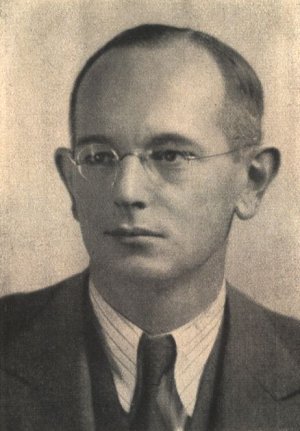<Back to Index>
- Mathematician Wilhelm Cauer, 1900
- Furniture Designer and Architect Gerrit Thomas Rietveld, 1888
- Nobleman Robert Dudley, 1st Earl of Leicester, 1532


Wilhelm Cauer (June 24, 1900 – April 22, 1945) was a German mathematician and scientist. He is most noted for his work on the analysis and synthesis of electrical filters and his work marked the beginning of the field of network synthesis. Prior to his work, electronic filter design used techniques which were essentially approximation methods, as no exact answers were produced for the behaviour of the filter under real conditions. This required a certain amount of experience on the part of the designer to choose suitable sections to include in the design. Cauer placed the field on a firm mathematical footing, providing tools that could produce exact solutions to a given specification for the design of an electronic filter. He died in Berlin during the Soviet capture of the city in 1945.
Wilhelm Cauer was born in Berlin, Germany, on June 24, 1900. He came from a long line of academics. His early grammar school was located in Cauerstrasse, named after his great-grandfather, the founder of the school. He later attended the Mommsen Gymansium, Berlin. His father, also Wilhelm Cauer, was a Privy Councillor and a professor of railway engineering at the Technical University of Berlin. Cauer became interested in mathematics at the age of thirteen and continued to demonstrate that he was academically inclined as he grew.
Briefly,
Cauer served in the German army in the final stages of World War I. He
married Karoline in 1925 and eventually fathered six children. Cauer started off in a field completely unrelated to filters; from 1922 he worked with Max von Laue on general relativity, and his first publication (1923) was in this field. For reasons that are not clear, he changed his field after this to electrical engineering. He graduated in applied physics in 1924 from the Technical University of Berlin. He then spent a period working for Mix & Genest, a branch of the Bell Telephone Company,
applying probability theory to telephone switching. He also worked on
timer relays. He had two telecommunications related publications during
this period on these subjects; The relationship of Mix & Genest with Bell gave Cauer an easy path to collaboration with AT&T's engineers at Bell Labs in
the US which must have been of enormous help when Cauer embarked on a
study of filter design. Bell were at the forefront of filter design at
this time with the likes of George Campbell in Boston and Otto Zobel in New York making major contributions. However, it was with R. M. Foster that Cauer had much correspondence and it was his work that Cauer recognised as being of such importance. His paper, A reactance theorem, is
a milestone in filter theory and inspired Cauer to generalise this
approach into what has now become the field of network synthesis. In June 1926 Cauer presented his thesis paper, The realisation of impedances of specified frequency dependence, at the Institute of Applied Mathematics and Mechanics of the Technical University of Berlin. This paper is the beginning of modern network synthesis. In 1927 Cauer went to work as a research assistant at Richard Courant's Institute of Mathematics at the University of Göttingen. In 1928 he obtained his habilitation and became an external university lecturer. Cauer found that he could not support his family during the economic crisis of the 1920s and in 1930 took his family to the USA where he had obtained a scholarship (a Rockefeller fellowship) to study at MIT and Harvard University. He worked with Vannevar Bush who was building machines for the solution of mathematical problems. Essentially, these were what we would now call analogue computers: Cauer was interested in using them to solve linear systems to aid in filter designs. His work on Filter cicuits was completed in 1931 while still in the US. Cauer met, and had strong contacts with, many of the key researchers in the field of filter design at Bell Labs. These included Hendrik Bode, George Campbell, Sidney Darlington, Foster and Otto Zobel. For a short while, Cauer worked for the Wired Radio Company in
Newark, New Jersey, but then returned to Göttingen with the
intention of building a fast analogue computer there. However, he was
unable to obtain funding due to the depression. Cauer
seems to have got on very poorly with his German colleagues. According
to Rainer Pauli, his correspondence with them was usually brief and
business-like, rarely, if ever, discussing issues in depth. By
contrast, his correspondence with his American and European
acquaintances was warm, technically deep and often included personal
family news and greetings. This correspondence went beyond his American contacts and included A.C. Bartlett of the General Electric Company in Wembley, Roger Julia of Lignes Telegraph Telephone in Paris, mathematicians Gustav Herglotz, Georg Pick and Hungarian graph theorist Dénes Kőnig. After leaving the Technical Institute for Mix & Genest, Cauer sought to become active in the Verband Deutscher Elektrotechniker (VDE, the German Electrical Engineers Society). He left the VDE, however, in 1942 after a serious falling out with Wagner, previously his PhD supervisor and ally. The rising force of Nazism became
a major obstacle to Cauer's work from 1933 onwards. The anti-Jewish
hysteria of the time forced many academics to leave, including the
director of the Mathematics Institute, Richard Courant. Although Cauer was not Jewish, it became known that he had a Jewish ancestor, Daniel Itzig, who had been a banker to Frederick II of Prussia.
Although this was not sufficient to have Cauer removed under the race
laws it stifled his future career, he gained the title of professor but
was never given a chair. By
1935 he had three children who he was finding it increasingly difficult
to support which prompted him to return to industry. In 1936 he
temporarily worked for the aircraft manufacturer Fieseler at their Fi 156 Storch works in Kassel and then became director of the laboratory of Mix & Genest in Berlin. He did however, continue to lecture at the Technical University in Berlin from 1939. In 1941, the first volume of his main work, Theory of Linear AC Circuits was published. The
original manuscript to the second volume was destroyed as a result of
the war. Although Cauer was able to reproduce this work, he was not
able to publish it and it too was lost during the war. Some time after
his death, however, his family arranged for the publication of some of
his papers as the second volume, based on surviving descriptions of the intended contents of volume II. After taking his children to stay with relatives in Witzenhausen (in Hesse) to protect them from the expected fall of Berlin to
the Russians, Cauer, against advice, returned to Berlin. His body was
located after the end of the war in a mass grave of victims of Russian
executions. The reason for the executions could not be established but
appeared to be random revenge killings. It is quite unlikely that Cauer
was killed because of who he was, given that Soviet Intelligence was
actively looking for scientists they could use in their own researches
and Cauer was known to be on their list of people to find. The major part of Cauer's legacy is his contribution to the network synthesis of passive networks. Indeed, he is considered the founder of the field. He treated network synthesis as being the inverse problem of network analysis.
Whereas network analysis asks what is the response of a given network,
network synthesis on the other hand asks what are the networks that can
produce a given desired response. Cauer solved this problem by
comparing electrical quantities and functions to their mechanical
equivalents. Then, realising that they were completely analogous,
applying the known Lagrangian mechanics to the problem. According
to Cauer, there are three major tasks that network synthesis has to
address. The first is the ability to determine whether a given transfer
function is realisable as an impedance network. The second is to find
the canonical (minimal) forms of these functions and the relationships
(transforms) between different forms representing the same transfer
function. Finally, it is not, in general, possible to find an exact
finite-element solution to an ideal transfer function - such as zero
attenuation at all frequencies below a given cutoff frequency and
infinite attenuation above. The third task is therefore to find
approximation techniques for achieving the desired responses.